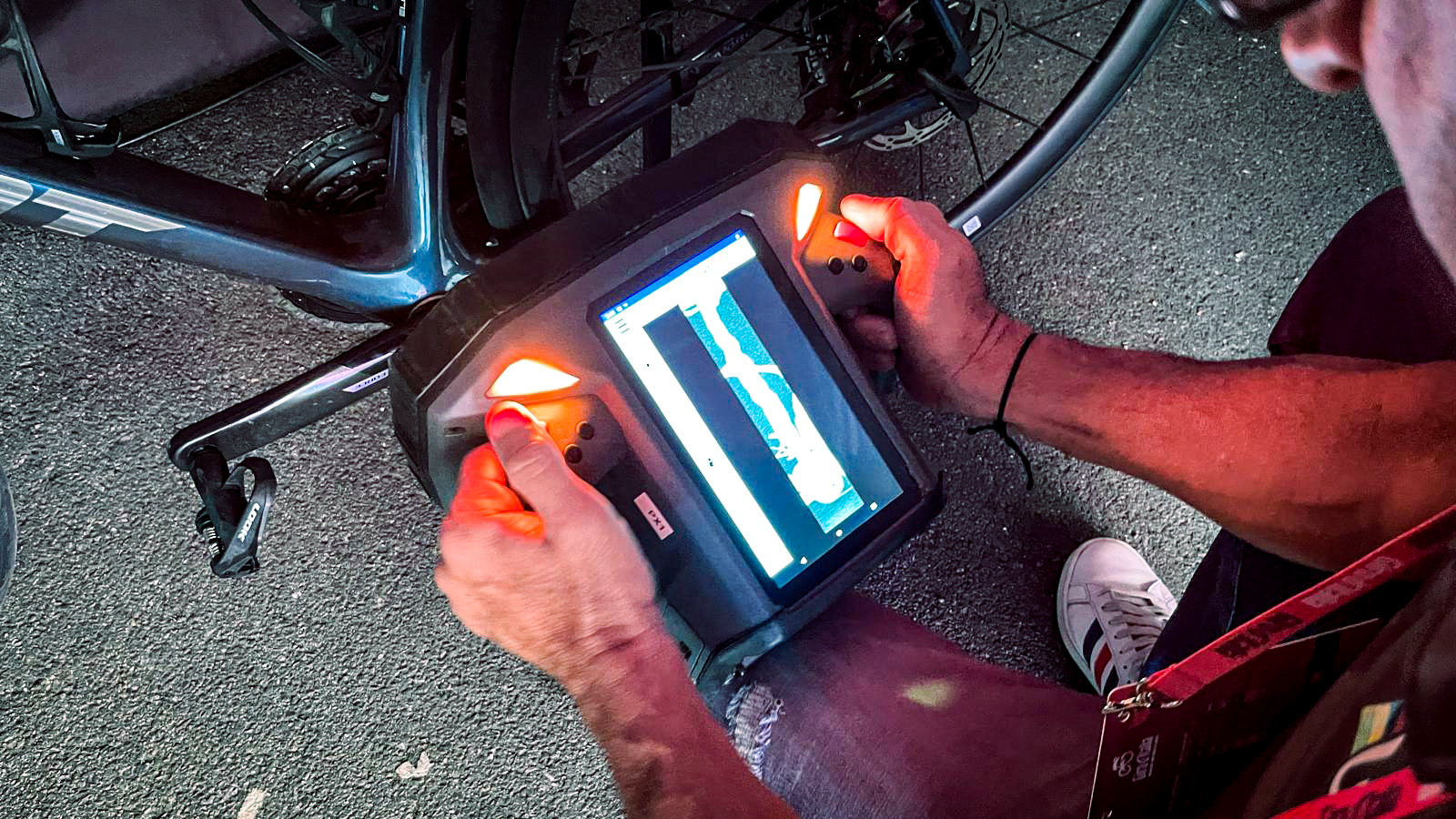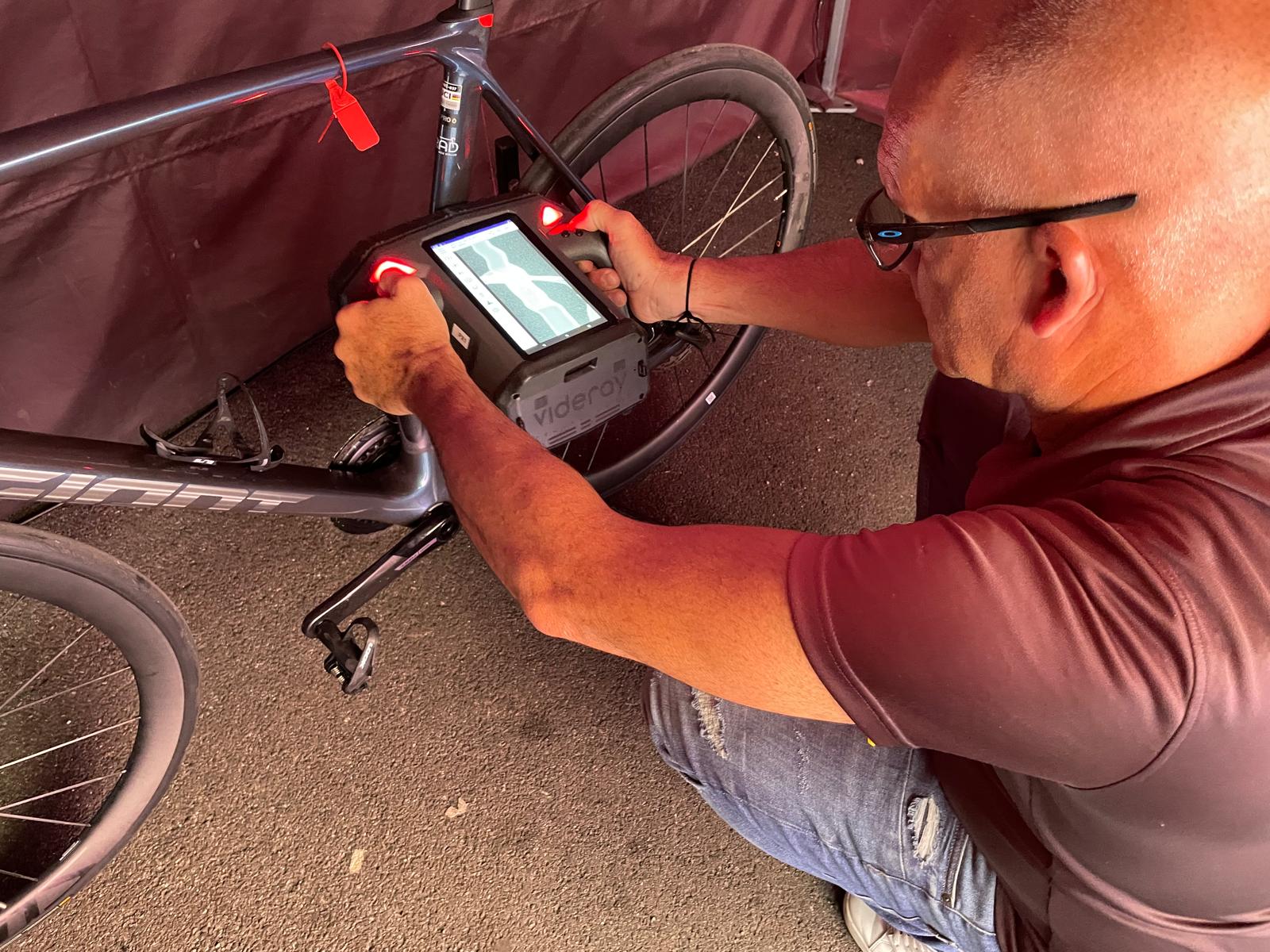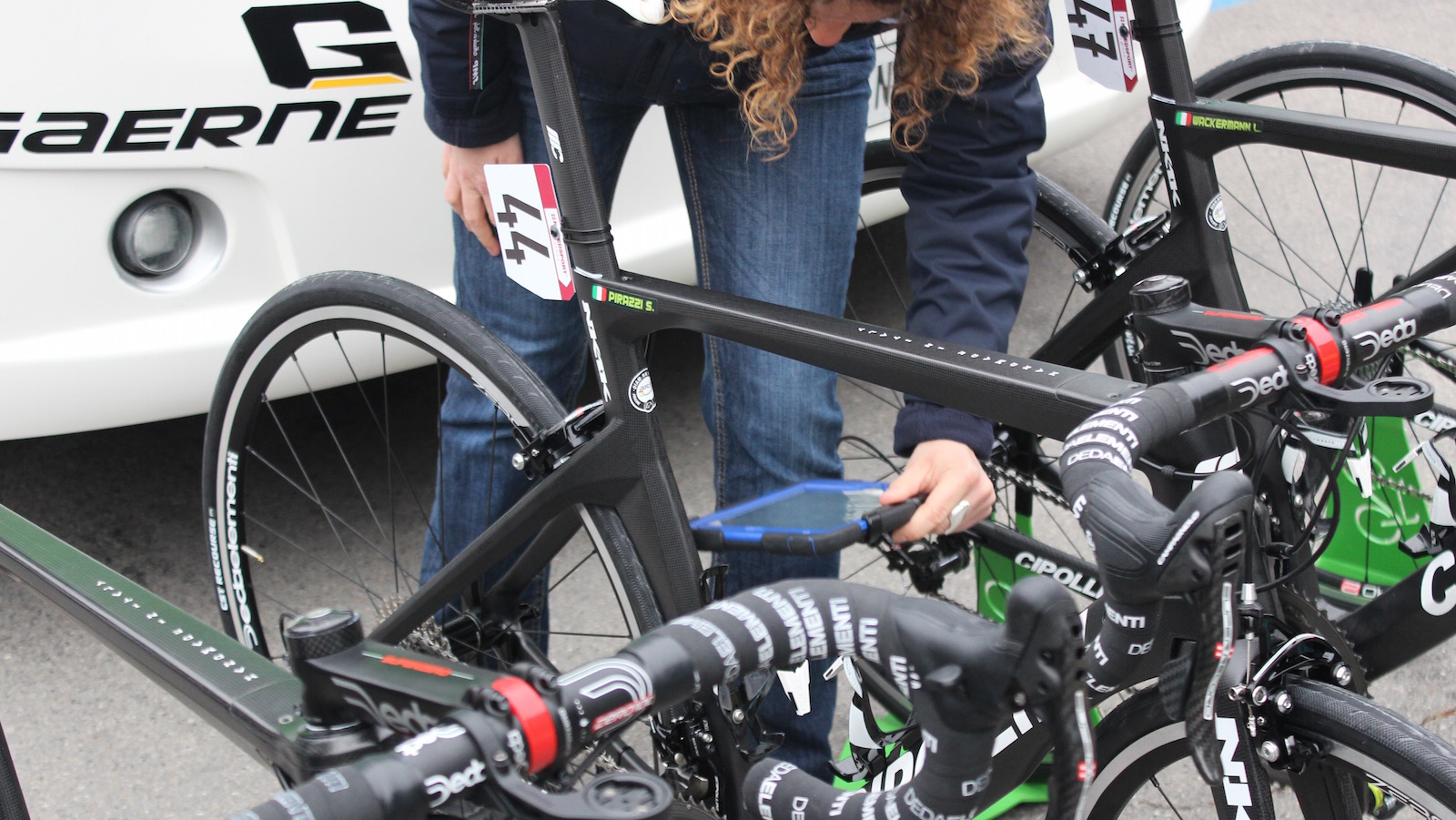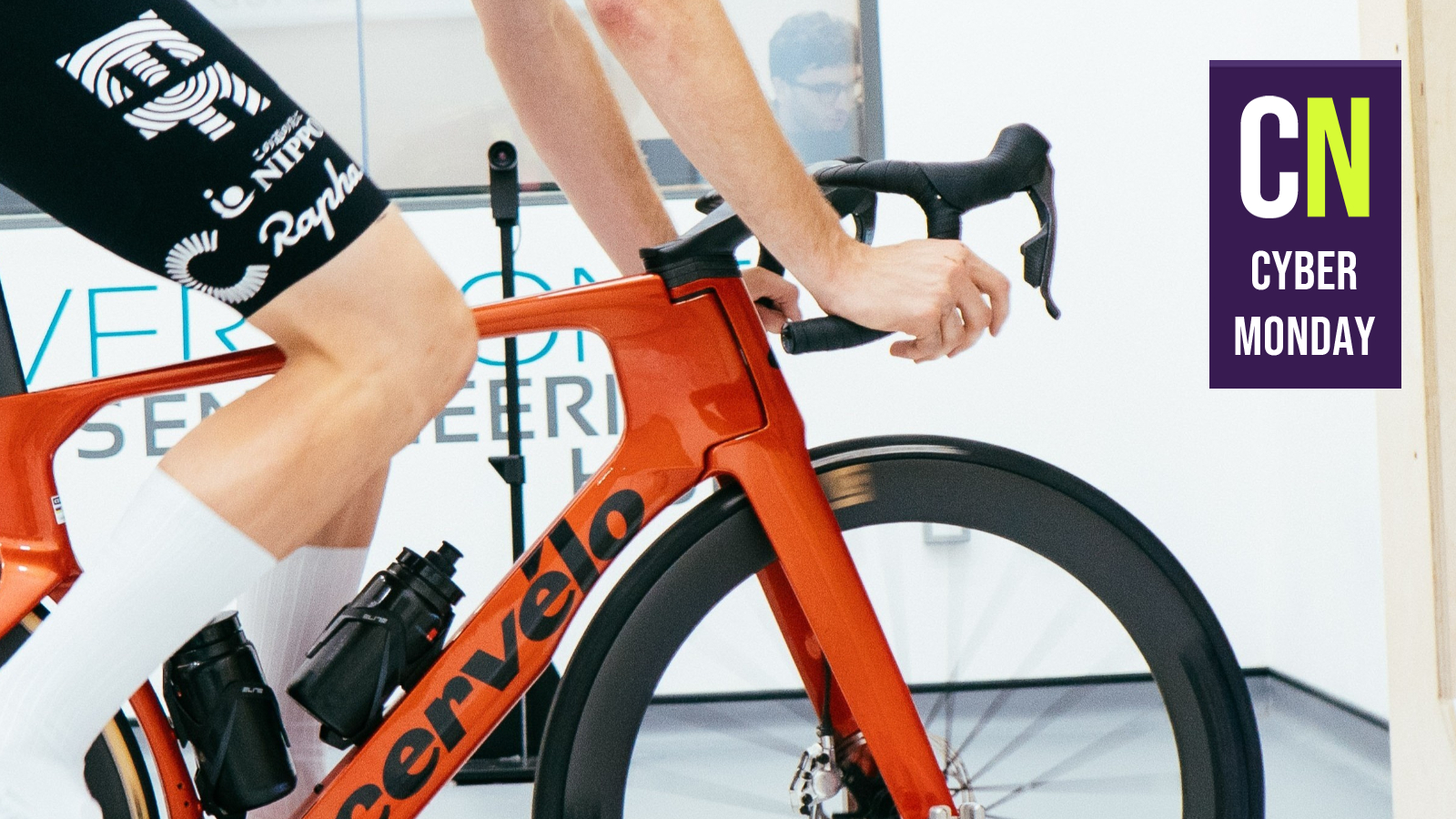'We're in a technological arms race' - How the UCI's Nick Raudenski is fighting mechanical doping
Cyclingnews sees how a handheld backscatter x-ray device sees inside bikes and components at the Giro d'Italia

The UCI has revealed details of their latest techniques and strategy to detect and deter mechanical doping in cycling, with bikes now checked using a handheld backscatter x-ray device that can see what is hidden inside frames, wheels and any part of a bike.
Cyclingnews and a select group of other media were allowed into the protected anti-doping and technological fraud compound at the finish of stage 18 of the Giro d'Italia in Cesano Moderno to see how the UCI carry out their checks.
The UCI appointed former US Homeland Security Investigator Nick Raudenski a year ago to lead the strategy for the fight against technological fraud. It was seen as a bold appointment by UCI president Davd Lappartient and perhaps a sign of the need to ensure hidden motors are not used to falsify results. Lappartient has admitted that a high-profile mechanical doping case would "destroy the sport."
Raudenski is using his experience investigating match-fixing and corruption for FIFA and UEFA, and more recent work as Head of Intelligence & Investigations at the anti-doping International Testing Agency, to combine bike checks with intelligence and whistleblowing.
"We're in a technological arms race," Raudenski admitted to Cyclingnews in an interview after the backscatter x-ray device presentation.
"Components are getting lighter and smaller and so easier to conceal and harder to detect. We're up against the challenge of trying to stay out in front or at least not so far behind in the cat and mouse game of what is the new way that people could potentially try to cheat."
It is not only equipment. Raudenski, like many people, is often suspicious of riders' performances in certain races. It sparks the natural investigator in him.
The latest race content, interviews, features, reviews and expert buying guides, direct to your inbox!
"It's about looking at the overall picture, watching how performances happen, watching biomechanical behaviour, watching how riders are acting and how they react to us when we do a bike check," he explained.
"Most are actually happy and thank us because they want to be sure they're not riding against somebody that is trying to cheat."
Cyclocross rider Femke Van den Driessche remains the only athlete ever to be caught and sanctioned for motor doping back in 2016.
British journalist Chris Marshall Bell has investigated mechanical doping a length for his Ghost in the Machine podcast and also written about motor doping for Cyclingnews on the subject. There are suspicions that hidden motors and even magnetic devices in wheels may have been used in major professional races, as far back as 1999, but no cases have ever been irrefutably proven or a disciplinary process opened.
"I and my team challenge ourselves to ask where we are at now and why we aren't finding anything," Raudenski said.
"We question if our tools are up to date, is the process right, is there new technology out there or new components that we are not seeing. It's a continued evolution to make our test and technology better. To make sure we're not missing something."
Inside the UCI technological fraud tent

The UCI has bike inspector technicians and the backscatter x-ray device at a number of major cycling and mountain bike races, to check bikes and create a strong sense of deterrence.
The UCI has three of the devices, which cost €45,000 each, with a considerable budget allocated to what the UCI prefers to call 'technological fraud' rather than mechanical doping.
Based on specific information and intelligence, suspicions or just a randomly selected process, riders are stopped beyond the finish line, a special red UCI tag is attached to their frame, and then taken to the anti-doping area for inspection. Riders who are selected for anti-doping testing usually face a bike check alongside random and targeted tests.
The UCI still uses the tablet device to check bikes at race starts, despite doubts about its ability to detect magnetic activity. They now combine that with between seven and 15 backscatter x-ray checks per day.
In the black UCI tent in the protected Giro d'Italia anti-doping compound, Cyclingnews saw how the UCI technicians weigh the bikes to detect any extra hidden equipment and then slowly scan the bike with the backscatter x-ray device.
The screen captures an X-ray image and clearly shows' inside the frame and wheels. The technicians are trained and experienced in differentiating between the batteries and wires of electronic gear systems and any hidden devices.
"We can see everything and every aspect, and we can look at specific areas and zoom in on details to highlight certain things," Raudenski said, insisting the process and technology are robust.

Riders and team staff are allowed to watch the process and then sign an official document saying the bike was checked on a specific day and time. The UCI keeps records of bikes tested and cross-checks that with bikes and frames registered with the UCI.
When David Lappartient was elected as UCI president in 2017, he said he didn't want technological fraud to continue as 'a hot topic' and he personally presented a mobile X-ray cabinet in 2018.
The use of the backscatter x-ray device is the latest step in the 'technological arms race.'
Cyclingnews has seen Raudenski at major race finishes as he supervises the bike check process. He keeps a low profile, but most teams already know who is and the vital work he does.
At recent Giro d'Italia stage finishes, Cyclingnews saw Raudenski point a handheld device, perhaps a heat gun of some kind, at riders' bikes slowing beyond the finish line. However, he refused to comment on the device or other technologies he and the UCI may use in the future.
The UCI are also apparently considering the use of power and cadence data, combined with AI, to produce a rider's "power passport" similar to the Athlete Biological Passport that is used to fight blood doping after the EPO era.
Raudenski admits that the UCI's work is mostly about acting as a deterrent. However, he is not afraid to investigate previous suspicious performances and equipment. They will be hard to prove but could help in the future to understand mechanical doping.
"People understand that if I cross the finish line with a motor on my bike, there's a high probability that there's going to be a check. So there is a deterrent effect," Raudenski said.
"We're making sure that we have robust processes, that our legal frameworks and the regulations are up to date, that the equipment regulations are up to date, and that we're staying ahead of what can and what can't be used."
Last September, the UCI launched a specific mechanical doping whistleblower rewards programme, saying that information to help target testing and investigations would be “facilitated through financial motivation, assistance, and/or reward for information".
Raudenski sees and studies all the rumours about hidden motors but focuses on the facts.
"Do I wake up sweating in the middle of the night, fearing that I'm missing something? Not at the moment," he told Cyclingnews.
"You have to separate fact from fiction, evidence from rumours. That's where I spend the majority of my time.
"It's not about what I think. It's about what I can prove. I'm driven by evidence, by things that I feel we take tangible actions on.
"Of course, we're not blind, we're not deaf to rumours and allegations that have happened in the past. I'm not shying away from anything that I feel is going to continue to promote the credibility of cycling."

Stephen is one of the most experienced members of the Cyclingnews team, having reported on professional cycling since 1994. Before becoming Editor-at-large, he was Head of News at Cyclingnews. He has previously worked for Shift Active Media, Reuters and Cycling Weekly. He is a member of the Board of the Association Internationale des Journalistes du Cyclisme (AIJC).
You must confirm your public display name before commenting
Please logout and then login again, you will then be prompted to enter your display name.
